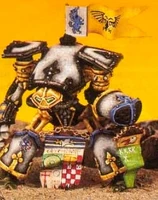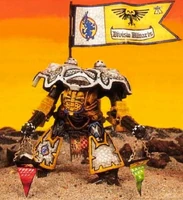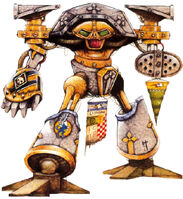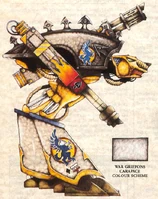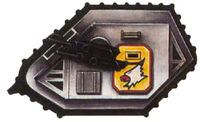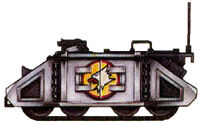"We are the weapons of the Omnissiah, born in His forges and armed with His wrath. Worlds quake beneath our tread and none can stand before us, for we are the will of the Omnissiah and all will know His glory."
- — Princeps Ultima Markus Jurrantur, Legio Gryphonicus
The Legio Gryphonicus ("War Griffons") is a Loyalist Titan Legion of the Collegia Titanica, one of the military arms of the Adeptus Mechanicus.
Regarded by many as one of the greatest of all Titan Legions and an exemplar of its kind, the Legio Gryphonicus or "War Griffons" to give them their more common appellation, suffered a trial by fire during the dark days of the Horus Heresy and remained true to their oaths to the Imperium of Man and unwavering in battle against the Traitor Legions.
Millennia later, in 997.M41, the homeworld of the Legio Gryphonicus suffered the devastation wrought upon it by the Tyranids of Hive Fleet Leviathan.
Legion History[]
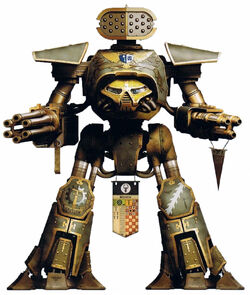
Legio Gryphonicus current colour scheme as displayed on the Reaver-class Titan Dictatio.
Origins[]
Gryphonne IV, the world of the Legio's founding, located in the Segmentum Tempestus, was known to have been a seat of technological might according to ancient myths predating the Age of Strife, and so formed one of the earliest attempts of the Martian Mechanicum to reach out into the darkness during Old Night.
While many such missions resulted in failure, doomed before the Emperor of Mankind's intervention in the creation of the Navis Nobilite, and many of the Mechanicum Arks were sundered or lost without trace, the expedition to Gryphonne IV met with great success.
This was likely a process of conquest over what local inhabitants remained rather than colonisation on the Mechanicum's part, although the truth of this matter has long since been sealed and forgotten by the Imperium. What is known is that after the founding of the Forge World of Gryphonne IV it quickly established itself as a power in its own right, expanding to dominate a pocket empire of eight nearby star systems which came to be known as the Gryphonne Octad.
Over the centuries that followed, the Mechanicum domain prospered and managed to maintain communication, albeit infrequent and fragmented, with distant Mars. Swearing its domains and arms to the service of the Great Crusade, Gryphonne marched to war at the Emperor's call, and would see its Titan Legion, one of the largest and most ably equipped outside Mars, see immediate action on many battlefronts.
Having extensive experience and proven tactical doctrines in fighting alongside the infantry forces of the Gryphonne Octad, the Legio Gryphonicus quickly gained a reputation for skill in close support of ground troops, and so was much in demand for assignment to the various expeditionary fleets.
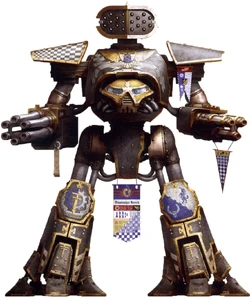
Legio Gryphonicus pre-Heresy colour scheme as displayed on the Reaver-class Titan Dominatus Revok.
The Legio however was loath to split its forces unduly on deployment, and instead served generally as an independent heavy contingent, assigned to various war zones as strategic needs demanded it.
This in turn led to the Legio Gryphonicus amassing battle honours alongside the Dark Angels, Imperial Fists and Death Guard Legiones Astartes at various times, and their inclusion in the order of battle for some of the most famous and vital campaigns of the Great Crusade, such as the Rangdan Xenocides and the Ullanor Crusade.
The martial culture of the War Griffons was one of fierce pride and honour. They valued discipline and skill amongst their Titan crew highly, and each princeps and moderatus strove to add glory to their own name and that of their bloodline and Legion, much in the manner of their kin in the Knight houses.
Each Titan of the Legio Gryphonicus in consequence became noted as being a visual testament to the war engine's own history of war, as well as the distinctions and battle honours earned by its crew.
So it was that when the War Griffons went striding to war, thunderous sirens howling and bedecked in heraldic banners proclaiming their might, it was taken as a sign to rejoice by the Imperialis Auxilia, who held the Legion's arrival as an avatar of victory or salvation in the midst of battle.
This lust for glory and individual achievement within the Legion's ranks did, however, lead to legendary rivalries among its princeps, and highly structured mechanisms were imposed for resolving such affairs of honour through duelling, a tradition which was held in abeyance however during open battle.
Such martial temper also led for some of its commanders -- particularly those assigned to god-engines such as the Warhounds already noted for their aggressive animus -- to develop reputations for impetuosity in battle, and refusal to retreat even when faced with the most overwhelming odds.
Horus Heresy[]

Legio Gryphonicus Warmaster-class Heavy Battle Titan Aureum Castigtor during the Horus Heresy.
Key also to their character was a fanatical loyalty to the Emperor and the ideals of the Imperium, beyond that even to their ties to the Mechanicum. It was this loyalty that was to count them among the Warmaster's foes without question when he turned traitor.
As the Great Crusade progressed into its later phases, the success of the Legio Gryphonicus on campaign, in conjunction with its size, led to it being assigned feudal rights as garrison-warders of a number of Mechanicum outposts and stations dispersed across the Imperium.
This served to both extend the Legio Gryphonicus' range and striking distance from its home base on Gryphonne IV (with which it always retained close ties) and finally to splinter its fighting forces into several sub-groups rather than the "sledgehammer" concentration of might it had been used to operating as.
At that time, it remained unclear in retrospect whether this was a mere happenstance of fate or perhaps whether it was part of the Warmaster's overall plan to scatter major forces he could not directly control prior to his revolt.
Regardless of this, when the Horus Heresy bloodily erupted, this powerful Titan Legion was a scattered force against the rebellion.
The tides of war would ensure that it would be the dark years of the Great Scouring before the surviving Titans of the Legio Gryphonicus would gather together again upon their ancient mustering grounds at the Plain of Achemados on the Forge World of their founding.
Nevertheless, the scattered battlegroups of the Legio Gryphonicus participated in many of the bloodiest battles of the Horus Heresy, including the Battle of Tallarn where they arrived as part of the first wave of reinforcments.
Hive Fleet Leviathan[]
When Gryphonne IV was threatened by the approach of the Tyranid Hive Fleet Leviathan in 997.M41, the Adeptus Mechanicus refused to abandon this important Forge World to Exterminatus. Isolated and alone, and left for dead in an abandoned star system, the Legio prepared for war. Before the arrival of the hive fleet, Gryphonne IV boasted some of the finest defences of any Imperial world within the southern reaches of the galaxy.
Gryphonne IV's War Griffons Titan Legion was feared for its world-breaking firepower and its Skitarii Legions, whom were envied across the Adeptus Mechanicus for their discipline and precision.
Yet, it was not enough to halt the Tyranid onslaught. The Skitarii were annihilated and devoured by waves of inexhaustible Hormagaunts and their Titan Legions torn asunder by Tyrannofexes and Tyranid Bio-Titans.
Gryphonne IV was ever after a Dead World -- a grim testament to the folly of hubris and pride. The Legio Gryphonicus was presumed to be destroyed in the conflict, but later appeared during the 13th Black Crusade to help augment Imperial forces by deploying the entire Legion in defence of the Fortress World of Cadia.
Notable Campaigns[]
- Rangdan Xenocides (Late 800s.M30) - After swearing its domains and arms to the service of the Great Crusade, the Legio Gryphonicus marched to war at the Emperor's call, one of the largest and most ably equipped outside Mars. Loath to split its forces unduly on deployment, the Legio Gryphonicus instead served generally as an independent heavy contingent, assigned to various war zones as strategic needs demanded it. They served alongside the vaunted Dark Angels Legion during the vital campaign known as the Rangdan Xenocides, and hurled themselves and broke their greater strength in countless battles against the vile xenos on the edge of the Halo Stars. This campaign culminated in the Third Rangdan Xenocide around 890.M30, which resulted in the loss of 50,000 Space Marines spent in preventing the destruction of perhaps the entire northern Imperium by the menace from the outer darkness.
- War Within the Webway (004-010.M31) - When Magnus the Red, primarch of the Thousand Sons, learned of Horus's fall to Chaos and attempted to warn the Emperor using psychic arts forbidden by the Edict of Nikaea, he inadvertently unmade his father's great work, destroying the psychic wards around the Imperial Palace and breaching the Imperial Webway gate by allowing a Warp rift to open up within the dungeons of the palace. Thousands of hideous Daemons poured into the Webway and immediately set about attacking the Imperial forces within. The workers of the Mechanicum were slaughtered in their thousands and the Custodian Guard were hard-pressed to hold back the tide of daemonic fury that had been unleashed upon them. As the Imperial forces within the Webway were being attacked, the Emperor mustered the remainder of His Custodian bodyguard and the Null-Maiden warriors of the Silent Sisterhood. Slowly, but surely, the Imperial forces pushed the blockades forward as the pressure from the Daemons' attacks waned. As the war raged on, new troops appeared amongst the hordes of Daemons attacking the Imperial forces. The powers of Chaos sent foully corrupted Heretic Astartes, Chaos Titans and other war machines into the Webway to try and force a victory. God-engines from the Legio Gryphonicus battled alongside the Custodians and Silent Sisterhood against the forces of Chaos within the Webway, helping to hold the encroaching hordes of Daemons, Chaos Titans and other Heretic forces from reaching Terra. After five standard years of continuous fighting, the War Within the Webway soon took a turn for the worse, as Imperial forces suffered many casualties. Finally, the Emperor Himself intervened, and was able to turn back the tide of the Neverborn with his formidable psychic powers. The Emperor's actions gave the surviving Imperials enough time to evacuate the Webway, and as Chaos forces closed on the portal once more the Master of Mankind mounted the Golden Throne and sealed the gate.
- First Battle of Paramar (673.006.M31) - The Legio Gryphonicus participated in the failed Loyalist defence of the strategic world of Paramar V.
- Ruin of Maerdan (008.M31) - In the third year of the Horus Heresy, the Imperial colony world of Maerdan on the edge of the Segmentum Solar became a savagerly contested frontline between the forces of Loyalist and Traitor. Maerdan's cities became flaming ruins and its once-verdant plains were turned to barren wastes, crushed and scoured by the fury of the battle as the Loyalist Titans of the Legio Gryphonicus, Legio Metalica and Legio Destructor clashed with the Traitors of the Legio Mortis, Legio Argentum and Legio Vulturum. The Ruin of Maerdan, as the campaign came to be known, was one of the largest Titan battles of the early Horus Heresy, with more than 200 Titans taking to the field against each other. Heavy losses were incurred by both sides and as the war moved on, it lefta shattered world behind, with neither Loyalist nor Traitor able to claim true victory. The flames of hatred between the Legio Gryphonicus and Legio Mortis, once staunch allies, burned bright after Maerdan and their enmity would lead them to seek each other out time and again on the fields of battle in the dark years that followed.
- Battle of Molech (009.M31) - Molech was a Knight World ruled over by House Devine ever since the Emperor Himself led an expedition to bring it into the fledgling Imperium and left a significant garrison there. The planet thrived under the rule of Devine, the populace of its capital city of Lupercalia never knowing the true reason why the Emperor had taken it upon Himself to lead the force that claimed it. Unfortunately for the citizens of Molech, the traitor Horus knew exactly what lay beneath the city that had been name in his honour -- a Warp Gate which, it was said, had allowed the Emperor to convene with the Ruinous Powers themselves. When Loyalist forces became aware of the Traitor fleet's approach, they mustered at Molech. As well as a trio of Titan Legions -- Legio Gryphonicus, Legio Crucius, and Legio Fortidus -- there were elements of each of the Imperium's fighting forces, including nearly a dozen Knight Houses which owed fealty to Devine. The Traitor force was equally impressive, featuring no fewer than four Titan Legions: the Legio Vulpa, Legio Interfector, Legio Vulcanum I, and the infamous Legio Mortis. As the Warmaster unleashed a massive coordinated assault, the planet's defenders were thrown into disarray when the Plasma Reactor of an Imperator-class Titan was destroyed. Thousands of Loyalists were immolated in a blinding flash as a miniature sun erupted from the Titan's core to leave a smoking crater half a Terran mile wide. In the wake of the catastrophic blast, the spearhead of Traitor Titans marched through the gap in the Imperial lines. At the height of the battle, House Devine revealed its true allegiance to the Warmaster, its treachery unveiled at a pivotal moment, heralding a slaughter from which only a handful of Loyalists escaped. Caught between the treacherous Knights of House Devine and Horus' rampant forces, the shattered remnants of Molech's defenders were slaughtered without mercy. They were totally defeated, so brutally that only one in a hundred of the troops of the Imperial Army survived the campaign. After his passage through the portal into the Realm of Chaos, Horus won the full blessing of the Ruinous Powers as their champion. His drive on Terra seemed unstoppable.
- Battle of Tallarn (010-012.M31) - During the Horus Heresy, Perturabo, Primarch of the Iron Warriors, launched an all-out planetary invasion of the verdant Imperial staging world of Tallarn, his IV Legion bolstered by dozens of allied Traitor Imperial Army regiments, the Titans of the Legio Krytos and the Knights of House Caesarean. Both the Loyalist and Traitor high commands were taken by surprise by Perturabo's actions and the invasion quickly escalated after he ordered an Exterminatus upon the world, scouring its surface of living matter by way of a voracious Life-eater virus bomb barrage. While the population of the once-verdant world was all but wiped out, many defenders survived thanks to extensive subterranean shelters. The ensuing campaign was fought between vast formations of Imperial Army and Solar Auxilia tanks, the Titans of the Legio Gryphonicus, the Knights of House Megron, the indentured Battle-Automata of the household army of the Rogue Trader Sangrea as well as the armoured forces of the Iron Hands, Imperial Fists, White Scars and Ultramarines Legions. No infantry could survive in the poisoned wastes, and the war quickly drew in other forces from across the Segmentum Tempestus. The Battle of Tallarn is considered the largest armoured engagement in the known history of Humanity, and while counted as a victory for the Loyalists, millions of warriors and war machines on both sides were left scattered across the lifeless, deadly surface of the planet.
- Battle of Yarant (012.M31) - The Battle of Yarant was a joint Imperial campaign conducted by the Raven Guard, scattered elements from the Space Wolves Legion and Titans from the Legio Gryphonicus on the world of Yarant III. However, the Loyalists were severely outnumbered and seeing the futility of their cause, the Primarch Corax ordered that all Imperial forces withdraw, so that they would live to fight another day against the Warmaster Horus' forces.
- Imperial Muster at Beta-Garmon (012-013.M31) - For reasons only understood later in the war, the Ruinstorm that had been invoked by Lorgar, primarch of the Word Bearers, several standard years earlier during the Battle of Calth, began to abate across vast swathes of the galaxy. Loyalist high commanders were able to utilise the potent astropathic relay at Beta-Garmon to contact and recall formerly lost or stranded forces from across the war-torn reaches of the northern Imperium. The Imperial Muster at Beta-Garmon rapidly escalated into the largest gathering of Loyalist might since the early years of the war, a concentration of forces so mighty that the Traitors had to respond in kind. The resulting clash of arms would become known as the Great Slaughter, a theatre of war of such scale that it would encompass the "Titandeath" and the Sea of Fire campaigns, each major campaigns in their own right. By its end, both sides were so badly bled that their only remaining option for ultimate victory was to force a final, decisive confrontation. As history related, the final battle would be fought at Terra, but only after the weighty butcher's bill of the Great Slaughter was paid in full.
- Battle of Beta-Garmon, "The Titandeath" (006-013.M31) - The Legio Gryphonicus took part in the long and savage Beta-Garmon campaign, which included hundreds of war zones across dozens of worlds. Even before the greater armies of the Warmaster Horus reached the star cluster, the battle lines had long since been drawn, and fighting had been going on for many Terran years. It was a cauldron of battle that would consume millions of lives before its end and see the demise of entire Titan Legions, earning this campaign the dire moniker of "the Titandeath."
- Siege of Terra (014.M31) - The Siege of Terra was the final battle of the Horus Heresy waged upon the surface of the Imperial Throneworld itself against the overwhelming forces of the Warmaster Horus. The Legio Gryphonicus were one of several Titan Legions that took part in the intense fighting that determined the fate of the Imperium of Man and all of Humanity.
- Burning of the Hive City
- Garevo
- Battle of Valos
- Scouring of Tallarn (014.M31)
- Castra Campaign (Unknown Date.M38 or M39) - The Legio Gryphonicus worked in conjunction with the Skitarii forces of Gryphonne IV during this campaign, which is notable as being the first time when the Leman Russ Conqueror variant of main battle tank was fielded by the forces of the Imperium. Skitarii units equipped with these new tanks were easily able to keep up with the Titans as they encircled the forces besieging the hive city Castra Septus. Once the pocket was closed, the Traitors were utterly destroyed.
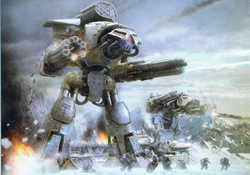
Legio Gryphonicus Titans in battle on Betalis III
- Betalis III Campaign (894.M41) - As commander of the 6th Cadian Armoured Regiment, and with the full power of the Consul Militant of the Betalis System, General Myndoras Odon issued a system-wide decree for Betalis to undergo a military build-up in preparation for a massive Eldar invasion that would become known in Imperial records as the Betalis III Campaign. In the vicinity of the Betalis System was a convoy destined for the Yarant System containing a Titan transport of the Legio Gryphonicus. General Odon forwarded an astropathic request to the War Griffons' home Forge World asking for their temporary reassignment. The request was approved and the Titan maniple numbering 8 war machines was re-routed to Betalis III. On the frigid plains of that world, Reaver and Warhound-class Titans closed and engaged with the Revenant and Phantom-class Titans of the Mymeara and Alaitoc Craftworlds. To search the vast frozen wasteland, the War Griffons split into two groups. The first group, the demi-maniple Invictus, moved across the northern Alacian Plains, a single Reaver-class Battle Titan flanked by a pair of Warhounds. The second and larger group, the Exaro maniple, consisting of 3 Reaver Titans and a pair of Warhounds, swept up from the south. They were both shadowed by the few heavy armour units of Battle Group Odon that the 6th Cadian Armoured could secure in the short time they had to assemble their forces. The first group closed and engaged with the Eldar Titans, but found itself outmatched by the graceful machines and lost one of their Warhound Scout Titans, the Magna Canis, in the fighting, while the Reaver was damaged by the plasma reactor explosion that was the result of the Titan's destruction. The demi-maniple was saved only by the arrival of the Exaro maniple. The War Griffons would once again come into conflict with the Titans of the Eldar Craftworlds on the eastern continent of Betalis III. Facing an enemy half their number but significantly superior in terms of armament and speed, the Imperial Titans' Princeps knew that the odds were stacked against them as they stepped into battle once more. Splitting their battle group once again, the demi-maniple Nova was short one war engine after the destruction of one of their Warhounds. The two Titan groups met in a series of skirmishes and assaults that extended over half the length of the continent. A furious final engagement eventually ensued between the Titans of both races. Neither side escaped unscathed, as they both took grievous losses in the battle. Though most of the Imperium's Titans suffered from serious battle damage in this final engagement of the conflict, they emerged victorious. The War Griffons claim to have destroyed three Revenant-class Titans on Betalis III and although none of the Eldar Phantom-class Titans were destroyed outright, the Titans of the Legio Gryphonicus inflicted enough damage upon them to force their retreat from the field. Without the intervention of the Titans of the War Griffons, the Imperial war for Betalis III may have had a very different outcome.
- 13th Black Crusade (999.M41) - When Abaddon the Despoiler and his Forces of Chaos assaulted the world of Cadia during the 13th Black Crusade in 999.M41, the Legio Gryphonicus was one of the Loyalist Titan Legions of the Collegia Titanica to aid in the defence of that beleaguered Imperial Fortress World. The entire Legion was deployed to throw back the hordes of Chaos fanatics.
Legion Specific Wargear[]
- Enhanced Auspex Relays - The Warhound Titans of any Titan Legion are at their best when ranging ahead of their battlegroup, and those of the Legio Gryphonicus exemplify this more than any other. In keeping with their Titan Legion's tradition of staunch individuality, Legio Gryphonius Warhound Princeps tend not to hunt in packs, preferring to strike out alone and bait the enemy at close range. The tech-adepts of Gryphonne IV have worked long and hard to capitalise on this fearless behaviour, and have developed enhanced auspex relays which transfer close range target data back to the rest of the battlegroup.
- Gravatus Plating - Where a Reaver Titan of the Legio Gryphonicus is to be fielded in place of a larger Battle Titan, its hull is often fitted with heavier armour plating to reflect its enhanced frontline role.
- Motive Sub-Reactors - Although Reaver Titans are not designed to act as scouts, Legio Gryphonicus has them in such great numbers that it is sometimes necessary for them to be adapted to the role. The most effective method involves the installation of a secondary plasma reactor at the top of each leg, allowing the Titan to operate at full locomotive capacity without drawing on the main reactor.
Notable Titans[]
- Warscorn (Imperator-class Titan) - The Warscorn was an Imperator-class Titan of the Legio Gryphonicus that fought in the Third Battle of Nyrcon as part of the wider Battle of Beta-Garmon, also known as the "Titandeath."
- Aureum Castigtor (Warmaster-class Titan) - The exact number of Warmaster Heavy Battle Titans that existed prior to the Horus Heresy is, by virtue of the secretive existence they led, impossible to determine. Even the most ancient and lauded of Titan Legions such as the Legio Gryphonicus are estimated, at most, to have been capable of fielding less than half a dozen Warmaster Titans. The Aureum Castigtor depicted above is an example of a War Griffons Warmaster Heavy Battle Titan, one of three such god-engines that can be definitively placed in service to the Legio. Suzerain Pattern Plasma Destructors were a common component of a Warmaster Titan's loadout, capable of the annihilation of all but the mightiest of edifices with contemptuous ease.
- Argent Monarch (Warlord-class Titan) - An ancient Warlord-class Battle Titan depicted below that fought during the Great Crusade and Horus Heresy eras.
- Iron Regent (Warlord-class Titan) - An ancient Warlord-class Battle Titan that was deployed to the Battle of Tallarn during the Horus Heresy.
- Aeterno Rex (Reaver-class Titan) - An ancient Reaver-class Battle Titan that was destroyed by the Knights of House Perdaxia at the Ruin of Maerdan during the Horus Heresy.
- Dominatus Revok (Reaver-class Titan) - An ancient Reaver-class Battle Titan that fought during the Great Crusade and Horus Heresy eras.
- Exaro (Reaver-class Titan) - The Exaro took part in the campaign on Betalis III and was the war engine of the commander of the larger maniple which operated there.
- Fidelis Natus (Reaver-class Titan) - An ancient Reaver-class Battle Titan that fought during the Great Crusade and Horus Heresy eras.
- Invictus Nova (Reaver-class Titan) - The Invictus Nova is the most ancient war engine within the Legio Gryphonicus. Over its millennia of existence, the Invictus Nova has seen action against many of the xenos races infesting the galaxy. Its previous experience fighting Aeldari Revenant-class Titans was crucial to the Imperial Titans' success during the defence of Betalis III. The vital intelligence stored within the Invictus Nova's Cogitators enabled its Princeps to quickly locate the vulnerable points within the similarly designed Aeldari Phantom-class Titans' holo-fields, and although none of the xenos Phantoms were destroyed outright, the Titans of the War Griffons inflicted enough damage upon to cause them to retreat from the field. The machine itself was damaged during its first encounter with Eldar Titans, but it continued to take part in battlefield operations.
- Paladin Argentus (Reaver-class Titan) - An ancient Reaver-class Battle Titan that led War Maniple "Herald Imperator" in the defence of Paramar V during the open days of the Horus Heresy. War Maniple "Herald Imperator" was stationed at the Paramar Nexus landing fields at the time of the 1st Battle of Paramar. The Titans had all undergone extensive repairs following damage sustained in battle against apex-grade xenos entities in the Golgothan Wastes, and the maniple had only been declared fit for active service mere days before the Alpha Legion attack. All were to fall in glory against the Traitor Legio Fureans (Tiger Eyes), the names of Titans, Princeps and Moderatii alike carved into the brazen Wall of Honour on their distant home Forge World.
- Celaritas Rex (Warhound-class Titan) - Celaritas Rex served as a part of War Maniple "Herald Imperator" and fell in glory during the 1st Battle of Paramar on the world of Paramar V during the opening days of the Horus Heresy.
- Gladius Lucida (Warhound-class Titan) - Gladius Lucida served as a part of War Maniple "Herald Imperator" and fell in glory during the 1st Battle of Paramar on the world of Paramar V during the opening days of the Horus Heresy.
- Magna Canis (Warhound-class Titan) - Magna Canis was one of two Warhound Scout Titans that was a part of the demi-maniple Invictus which supported the Reaver Battle Titan Invictus Nova. During an engagement on the Alacian Plains on Betalis III, the Magna Canis suffered catastrophic damage under the assault of an Eldar Phantom-class Titan, resulting in its destruction.
- Nobilis (Warhound-class Titan) - Nobilis fought in the Ullanor Campaign during the Great Crusade.
- Tempus Prima (Warhound-class Titan) - Tempus Prima was one of two Warhound Scout Titans that were a part of the demi-maniple Invictus which supported the Reaver Battle Titan Invictus Nova.
- Venator Lux (Warhound-class Titan) - Aeterno Rex fought in the Ruin of Maerdan during the Horus Heresy.
- Dictatio (Reaver-class Titan) - The Dictatio is a Reaver Titan active with the Legion in the late 41st Millennium.
Notable Personnel[]
- Princeps Ephraim - Ephraim is the princeps of the Reaver-class Titan Invictus Nova and overall commander of the Legio Gryphonicus battlegroup deployed to Betalis III.
Notable Legion Maniple Configurations[]
Axiom Battleline Maniple[]

Axiom Battle Maniple of the Legio Gryphonicus.
The Axiom maniple is one of the most sacred of Collegia Titanicus maniple configurations. It is both numerologically and strategically balanced, capable of dealing with almost any threat.
Mandatory Component[]
- One Warlord Battle Titan
- One Reaver Battle Titan
- One Warhound Scout Titan
Optional Components[]
- One Reaver Battle Titan
- One Warhound Scout Titan
Legion Strength[]
As a Primus-grade Titan Legion, the War Griffons were one of the most powerful military formations in the Adeptus Titanicus, and therefore the Great Crusade itself. The Legio Gryphonicus was roughly on par with other Primus-grade Legions such as the Legio Crucius (Warmongers) and the Legio Magna (Flaming Skulls), and was surpassed in size only by the giants of the Legio Mortis (Death's Heads) and the Legio Destructor (Beasts of Steel).
The Legio Gryphonicuss operational strength at the time of the Horus Heresy's outbreak was attested to stand at 176 god-engines of various classes and patterns, with roughly half of these being of the Reaver-class Battle Titan.
The remainder were split between various Scout Titans and larger Warlord Pattern Battle Titans, as well as several of the most powerful Nemesis and Imperator types.
The War Griffons Auxillia was also noted for its size and power, comprising six dedicated Legio Cybernetica cohorts and four battalions of specialised Skitarii support regiments.
These regiments were noted for the use of standard formation STC pattern armour and vehicles rather than the more specialised and unique war machines commonly favoured by Tech-Guard militia forces -- this unusual feature of their panoply being accounted for by direct supply of these battalions from Gryphonne IV's mass-manufactora, and also by the traditions of the Gryphonne Octad's defence forces.
The Legio Gryphonicus also possessed a noteworthy and unusually high number of Titan-Barques and Mass-Conveyors operating under its own fealty and allegiance. This substantial transport fleet rendered it largely independent of operation when the need arose, and would serve it well during the Heresy, enabling a degree of vital mobility and speed of action so it could both survive and engage the foe on its own terms.
The allied Knight houses whose Knights often serve alongside the Legio Gryphonicus include House Coldshroud, House Fvaber and House Cadmus. During the Battle of Beta-Garmon, the Legio Gryphonicus was supported by House Klaze and House Vyronii.
Legion Allies[]
Vassal Knight House[]
Knight Houses[]
- House Cadmus
- House Canis
- House Devine (Loyalist)
- House Donar
- House Fvaber
- House Idra
- House Kaska
- House Kaushik
- House Klaze
- House Mamaragon
- House Megron
- House Tazkhar
- House Vyronii
Space Marines[]
- Blood Angels
- Imperial Fists
- Iron Hands
- Iron Warriors (Loyalist)
- Space Wolves
- Ultramarines
- White Scars
Legion Appearance[]
Legion Colours[]
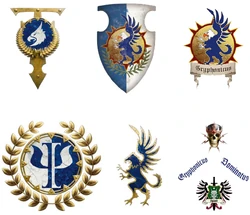
Legio Gryphonicus example iconography.
The colours of the Legio Gryphonicus are a dappled grey camouflage pattern with yellow or gold. Each Titan of the Legio Gryphonicus is a visual testament to the god-engine's own history of war, as well as the distinctions and battle honours earned by its crew.
When the War Griffons stride to war, thunderous sirens howling and bedecked in heraldic banners proclaiming their might, it is taken as a sign to rejoice by allied forces, who hold the Legio's arrival as an avatar of victory or salvation in the midst of battle.
Like most of the Titan Legions, the War Griffons maintain two distinct styles of war banner. The first is borne into the scorching fires of combat and commonly carries a simplified rendering of the Order's sigil. The second, bears the accounting of the full honours of the Titan and its crew, and to the practised eye speaks volumes of the god-engine's deeds and its place within the overall structure of the Order.
The honour banners of the War Griffons are widely acknowledged as examples of the very height of the heraldic arts in the Imperium, each one bearing full witness to the principles of duty and honour to which the Titan Legion is so utterly dedicated.
Legion Badge[]
The Legion badge of the Legio Gryphonicus is a rampant winged griffon on a field of yellow.
Sources[]
- Adeptus Titanicus - The Horus Heresy: Rulebook (Specialty Game), pp. 14-15, 56-57, 62-63, 72-73, 93-97
- Adeptus Titanicus - The Horus Heresy: Titandeath (Specialty Game), pp. 19-23, 91-95
- Adeptus Titanicus - The Horus Heresy: The Defence of Ryza (Specialty Game), pg. 92
- Adeptus Titanicus - The Horus Heresy: Doom of Molech (Specialty Game), pp. 7-11
- Adeptus Titanicus - The Horus Heresy: Loyalist Legios (Specialty Game), pp. 28-32
- Codex Titanicus (1st Edition), pp. 26, 31
- Codex: Eye of Terror (3rd Edition), pg. 16
- Codex: Tyranids (5th Edition), pg. 28
- Imperial Armour Volume One - Imperial Guard and Imperial Navy, pp. 8, 53
- Imperial Armour Volume Eleven - The Doom of Mymeara, pp. 18-19, 36-39, 50-52, 56, 106-107, 110, 205
- The Horus Heresy - Book Three: Extermination (Forge World Series) by Alan Bligh, pp. 19, 28-30, 160-163
- The Horus Heresy - Book Six: Retribution (Forge World Series) by Alan Bligh, pp. 12-32
- Warhammer Visions #25, "The God Machines," pg. 72-73
- White Dwarf 123 (March 1990), Back Cover
- White Dwarf 24 (August 2018), "Latest News - Collegia Titanicus: The Titan Legions," pg. 15
- White Dwarf 25 (September 2018), "Planet Warhammer," pg. 20
- White Dwarf 28 (December 2018), "Planet Warhammer - Adeptus Titanicus: The Horus Heresy," pg. 21
- White Dwarf 30 (February 2019), "Vassal Knight Houses," pp. 128-133
- Tallarn: Executioner (Novella) by John French, pg. 96
- Titandeath (Novel) by Guy Haley
- Old Earth (Novel) by Nick Kyme, Ch. 27
- Mortis (Novella) by John French
- Vengeful Spirit (Novel) by Graham McNeill, Chs. 16, 24-25
- Games Workshop Online Store: Legio Gryphonicus Transfer Sheet
- Warhammer Community - Warhammer Fest Live Blog (11 May 2018)
- Warhammer Community - Forge World Open Day: Return to Middle-earth (15 July 2018)
- Warhammer Community - Adeptus Titanicus Part 2: The Horus Heresy (07 Aug 2018)
- Warhammer Community - Adeptus Titanicus Part 4: Getting Started (09 Aug 2018)
- Warhammer Community - Adeptus Titanicus Part 5: Miniatures Showcase (10 Aug 2018)
- Warhammer Community - Adeptus Titanicus Part 6: The Titan Legions (14 Aug 2018)
- Warhammer Community - Warhammer Fest Europe: Live Blog (18 Aug 2018)
- Warhammer Community - Adeptus Titanicus: In Stores Now (18 Aug 2018)
- Warhammer Community - Reavers and Rotters - Next Week's Pre-Orders (26 Aug 2018)
- Warhammer Community - Adeptus Titanicus Part 11: Reaver Battle Titans (28 Aug 2018)
- Warhammer Community - This Week's Pre-Orders: A New Team and a New Titan (01 Sept 2018)
- Warhammer Community - Adeptus Titanicus: Duncan's War Griffons (06 Sept 2018)
- Warhammer Community - Adeptus Titanicus Part 12: Warhound Scout Titans (02 Oct 2018)
- Warhammer Community - Unleash the Warhounds! (06 Oct 2018)
- Warhammer Community - Titanic War Zones and Brutal Warriors (23 Nov 2018)
- Warhammer Community - Coming Next Week: Titans, Teams, Gangs and Army Sets (25 Nov 2018)
- Warhammer Community - This Week's Pre-Orders: Something for Everyone (01 Dec 2018)
- Warhammer Community - Wisdom of the Grand Master: Part 1 (08 Jan 2019)
- Warhammer Community - Pre-Order Next Week: Ambots, Titanic Weaponry and Speed Freeks! (24 Feb 2019)
- Warhammer Community - Adeptus Titanicus: Old Alliances (26 Feb 2019)
- Warhammer Community - Order Today: Ambots and Legends of the Skaven (02 Mar 2019)
- Warhammer Community - Why YOU Need the New Adeptus Titanicus Starter Set (04 Feb 2020)






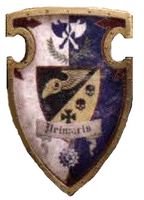
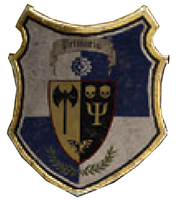


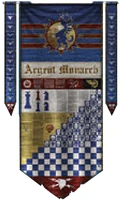




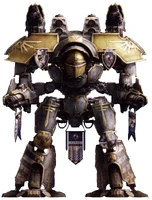
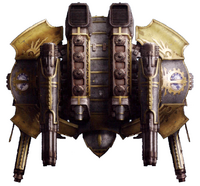




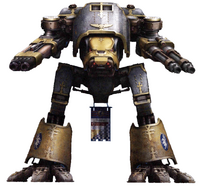
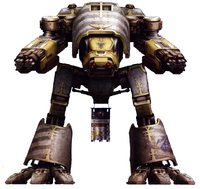

![Legio Gryphonicus Warhound.jpg (433 KB) A Legio Gryphonicus Mars Pattern Warhound-class Titan]]](https://static.wikia.nocookie.net/warhammer40k/images/0/0b/Legio_Gryphonicus_Warhound.jpg/revision/latest/scale-to-width-down/200?cb=20121114234554)




